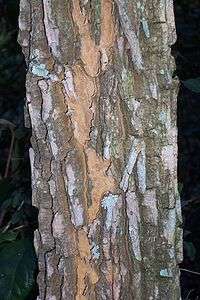Duboisia myoporoides
| Corkwood | |
|---|---|
| | |
| Corkwood | |
| Scientific classification | |
| Kingdom: | Plantae |
| (unranked): | Angiosperms |
| (unranked): | Eudicots |
| (unranked): | Asterids |
| Order: | Solanales |
| Family: | Solanaceae |
| Genus: | Duboisia |
| Species: | D. myoporoides |
| Binomial name | |
| Duboisia myoporoides R.Br. | |
Duboisia myoporoides, or Corkwood, is a shrub or tree native to high-rainfall areas on the margins of rainforest in eastern Australia. It has a thick and corky bark.[1] The leaves are obovate to elliptic in shape, 4–15 cm long and 1–4 cm wide. The small white flowers are produced in clusters. This is followed by globose purple-black berries (not edible).
Uses
The leaves are a commercial source of pharmaceutically useful alkaloids. The same alkaloids render all plant parts poisonous. The leaves contain a number of alkaloids, including hyoscine (scopolamine), used for treating motion sickness, stomach disorders, and the side effects of cancer therapy.[2]

Duboisia myoporoides bark at Wyrrabalong National Park, Australia
References
- ↑ Conn, Barry J. (2001). "Duboisia myoporoides – New South Wales Flora Online". PlantNET – The Plant Information Network System. 2.0. Sydney, Australia: The Royal Botanic Gardens and Domain Trust. Retrieved 28 May 2013.
- ↑ Low, Tim (1990). Bush Medicine, A Pharmacopoeia of Natural Remedies. Angus & Robertson. pp. 210–211. ISBN 0-207-16462-2.
Further literature
- Foley, Paul (2006). "Duboisia myoporoides: the medical career of a native Australian plant". Historical Records of Australian Science. 17 (1): 31–69. doi:10.1071/hr06001. Retrieved 28 May 2013.
This article is issued from
Wikipedia.
The text is licensed under Creative Commons - Attribution - Sharealike.
Additional terms may apply for the media files.